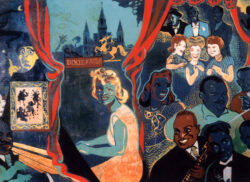Xavier Gonzalez
Artist Xavier Gonzalez's Depression-era murals continue to ornament buildings across the state.

Courtesy of Louisiana State Museum
Jazz Mural at Dixie’s Bar of Music. Gonzalez, Xavier (Artist)
Spanish-born painter and sculptor Xavier Gonzalez had a long and active career as teacher and artist across America and around the world. Much of his work, however, was completed in Louisiana, and his murals continue to ornament buildings in the state. While working for various New Deal agencies during the Depression, Gonzales painted murals in several Louisiana post offices and in New Orleans’s Shushan Airport. Combining elements of Cubism, American Regionalism, and the works of Mexican mural painters, Gonzalez’s work brought an international flair to the 1930s New Orleans art world.
Born on February 15, 1898, in Almeria, Spain, Xavier Gonzalez was the son of Emilio González Díaz de Paredes and Gracia Arpa Perea. He was also the nephew of renowned Spanish painter Jose Arpa, with whom he studied. As a boy, he moved to Argentina, then Mexico with his family. In 1925, he immigrated to the United States, settling in Chicago, where he studied at the Art Institute of Chicago. He taught art in the San Antonio, Texas, public school system before arriving in New Orleans to join the faculty of Sophie Newcomb College in 1931. While there, he met and married Ethel Edwards, also an artist. During the 1930s, the couple divided their time between New Orleans and Alpine, Texas, where Gonzalez ran an artists’ colony during the summer. They also traveled extensively in Europe, the Middle East, and Asia.
Though Gonzalez sculpted in various media, experimenting with numerous forms, he is primarily known as muralist. His early works include murals for the civic auditorium in San Antonio in 1933 and Shushan Airport (now known as New Orleans Lakefront Airport). The latter project actually involved the creation of eight separate 10′ x 10′ paintings, mounted in circular display like points on a compass. Much of Gonzalez’s work was commissioned by the Treasury Section of Painting and Sculpture, quickly dubbed “The Section,” and its smaller affiliate, the Treasury Relief Art Project (TRAP). Throughout the 1930s, these agencies hired artists to decorate new or refurbished federal structures, primarily post offices and court houses. Gonzalez quickly mastered the visual vocabulary popular among his New Deal patrons. His commissions included “Strawberry Farming” (TRAP, 1937) installed in the Hammond, Louisiana, post office; “Tennessee Valley Authority” (Section, 1937) for the federal courthouse in Huntsville, Alabama; and “Tung Oil Industry” (Section, 1939) for the post office in Covington, Louisiana. Gonzalez’s wife, Ethel, completed two additional Section commissions for post offices in Marfa, Texas, and Lake Providence, Louisiana.
In the mid-1940s, Gonzalez moved to New York City, where he remained for most of his life. During a renovation of Shushan Airport in 1946, several of his murals were covered by paneling. At a later date, one of the murals was removed, eventually becoming part of the Louisiana State Museum’s collection. Gonzalez’s 1963 abstract relief, “The History of Man,” however, remains on view in the lobby of David B. Steinham Hall on the uptown campus of the City College of New York. His work is also in the collections of the Metropolitan Museum of Art and the Whitney Museum of American Art, both in New York City. Gonzalez died of leukemia on January 9, 1993.
